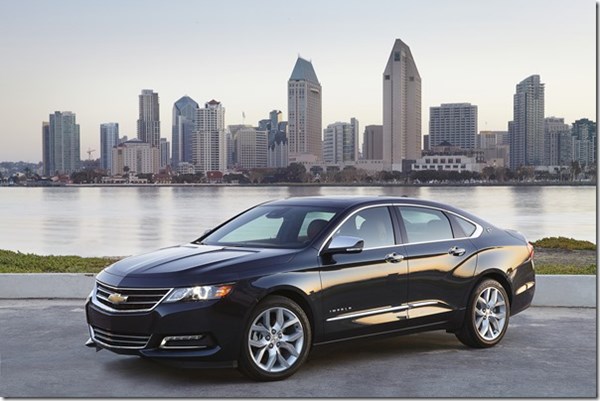2014 Chevrolet Impala 2LT
One of the interesting things that Alan Mulally did early on in his tenure at Ford was to bring back the Taurus.
#interior #electronics
One of the interesting things that Alan Mulally did early on in his tenure at Ford was to bring back the Taurus. The Taurus had given way to the Five Hundred. Few people remember the Five Hundred. Few people don’t know that there is a car called the “Taurus,” even if they aren’t all that interested in full-sized cars.
Which, nowadays, perhaps more than ever, few people seem to be.
The Taurus was, and is, a good car. But there is a particular drawback, which is that while it has a capacious trunk—20.1-cubic feet—it has truncated rear legroom: 38.1 inches.

Why, you might be wondering, am I talking about the Taurus when the headline up there says “Impala”?
That’s because this is a full-size sedan done right. Chevrolet goes so far as to call it its “flagship,” and the people who developed it ought to be damned proud of what they’ve accomplished, how they’ve massively improved on what is already a perennial best-selling full-size car.
That is, the rear legroom is 39.8 inches. Which is a heck of a lot more than in the back of the Taurus, even though the digits may not seem so disparate in size. Admittedly, its trunk is smaller, at 18.8 cubic feet.
But the real point of full-size sedans is to transport full-size people in comparative comfort whether they’re sitting in the front or rear, and the Impala delivers. Big time.

A passenger, after surveying the interior of the Impala, a passenger who long ago gave up on Detroit-based products, said with surprise, “I surely wouldn’t associate this with a Chevy.” And that was said in a good, positive way. It was said with more than a modicum of surprise.
Because the Impala’s design, inside and out, shows that the people involved realize that there is a significant number of people who have opted for non-Detroit-based sedans—Camrys and Accords, Sonatas and Altimas—and have consequently increased their levels of expectation when it comes to a family car. (Yes, the Impala is bigger than a Camry or an Accord, but chances are, when people are cross shopping, these are the two they might consider vs. an Impala—and chances are, there hasn’t been a whole lot of people who would consider cross-shopping one of those cars and an Impala, but now the Impala is sufficiently relevant to make comparisons completely understandable.)

What’s interesting about the car is that there isn’t one thing that one would point at and say that this is the key differentiator (not even the chrome trim that swoops around the instrument panel and glows blue at night when the headlamps are on, something that looks far more interesting than it sounds). Rather, it is the entire package, from the headlamps to the nicely formed body sides, from the front buckets to the 60/40 split fold rear seats, from the steering wheel controls to the MyLink infotainment system, that makes this car good.
The powertrain in this particular model is a 3.6-liter V6 mated to a six-speed automatic transmission. At 305 hp, it is nicely suited to the car. With a combined EPA number of 22 mpg, it is nicely suited for those who have to fill the car.

There are a couple of concerns. One is that the rear view of the car isn’t as fully realized as it might have been. That, of course, is purely subjective. A more objective measure is that of the price. The base price for the 2LT is $29,950. The car as-driven included $5,010 worth of options, so with the $810 destination added, the total is $35,770. For the 2013 Impala there are three trim levels to choose from (there are seven for the 2014), and the nearest seems to be the LT, which has a base price of $28,210. A $1,740 difference. Yes, you get a much nicer car for your money, but one wonders whether that might not cause a bit of sticker shock for those going to their local Chevy dealer.
Of course, when the average transaction cost for a car nowadays is on the order of $30,000, the Impala is certainly in the game.
Selected specs
Engine: 3.6-liter DI V6
Horsepower: 305 @ 6,800 rpm
Torque: 264 lb-ft @ 5,300 rpm
Material: Aluminum block and heads
Transmission: Hydra-Matic 6T70 six-speed automatic
Steering: Electric variable-assist rack-and-pinion
Wheelbase: 111.7 in.
Length: 201.3 in.
Width: 73 in.
Height: 58.9 in.
Passenger volume: 105 cu. ft.
Cargo volume: 18.8 cu. ft.
EPA: 19/29/22 city/highway/combined mpg
RELATED CONTENT
-
Mercedes-Benz Sprinter 2500 Passenger Van
It is hard to describe how large—more precisely, long and spacious—the Sprinter Passenger Van is in a meaningful way.
-
Lincoln Corsair Takes Flight
“We wanted to create a dramatic, youthful Lincoln with terrific harmony.” And with the Corsair, they’ve accomplished what they set out to do.
-
GM Seeks to Avert U.S. Plant Shutdowns Linked to Supplier Bankruptcy
General Motors Co. says it hopes to claim equipment and inventory from a bankrupt interior trim supplier to avoid being forced to idle all 19 of its U.S. assembly plants.


.jpg;width=70;height=70;mode=crop)